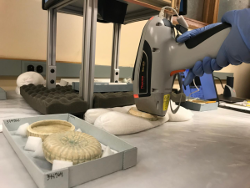|
Ray Gun Pinpoints Origin of Medieval Ceramics
February 11, 2019
Scientists have used a ray gun to determine the origin of a collection of medieval ceramics from a shipwreck. The wreck, recovered from the depths of the Java Sea in the 1990s, contained thousands of pieces of cargo, of which a large part has been recovered. The salvaged elements now make up the Java Sea Shipwreck collection at the Field Museum in Chicago. Among the things salvaged were dozens of porcelain ceramic bowls and boxes that were covered in qingbai, a blue-white glaze. Scientists knew that the style suggested that the ceramics came from China; what scientists didn't know was the exact origin. The scientists began by reviewing finds at other archaeological sites, to find evidence of origin, on the theory that an individual kiln site in long-ago China would have had a unique way of making its pottery. The next step was to determine with precision the elements of the 60 ceramic pieces chosen for the new study. The scientists employed an X-ray fluorescence detector–which closely resembles a ray gun right out of science fiction– in scans of the ceramic pieces. Comparing the X-ray scanning results with what they already knew, the scientists determined that the ceramics were made more than 2,000 miles from where the ship sank. Efforts to determine the origin were possible in part because the particular kind of porcelain used to make the ceramics was made at such a high temperature that it looked like nothing so much as glass; as a result, the ceramics have resided underwater for centuries without degrading significantly. The ship is thought to have left Fuzhou, then stopped in Quanzhou, in southeastern China, in the 12th or 13th Century. The destination was the Indonesian island Java. The ship sank near the island. Fishermen discovered the wreck in the 1980s, and the cargo was discovered a decade later. Results of the study, led by Wengpeng Xu of the University of Illinois at Chicago, and Lisa Niziolek, of the Field Museum, can be found in the February 8 issue of the Journal of Archaeological Science. |
Social Studies for Kids |
Social Studies for Kids
copyright 2002–2024
David White






